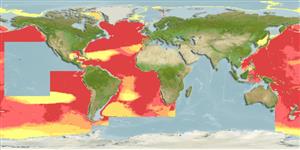Common names from other countries
>
Lophiiformes (Anglerfishes) >
Oneirodidae (Dreamers)
Etymology: Oneirodes: Greek, 'oneiros' = a dream or dreamlike or out of a dream (suggesting this fish is so strange and marvelous that can exist only in dreams) (Ref. 86949); eschrichtii: Named after D.F. Eschricht, Danish naturalist (Ref. 6885).
More on author: Lütken.
Environment: milieu / climate zone / depth range / distribution range
Ecología
marino batipelágico; rango de profundidad 750 - 2500 m (Ref. 86949). Deep-water
Circumglobal: In tropical to temperate waters. Eastern Atlantic: off Madeira, Portugal, Ireland and Iceland.
Tamaño / Peso / Age
Maturity: Lm ? range ? - ? cm
Max length : 28.8 cm SL macho / no sexado; (Ref. 5951); 29.7 cm TL (female)
Short description
Claves de identificación | Morfología | Morfometría
Radios blandos dorsales (total) : 5 - 7; Radios blandos anales: 4. Esca with anterior appendage bearing papillae and a few short filaments at distal tip; posterior appendage never branched. Characterized by having similar esca to that of O.bulbosus and O.anisacanthus; lacks numerous tapering distal filaments of the anterior appendage of O.bulbosus and lateral escal appendage of O.anisacanthus; subopercle without indentation on posterodorsal margin; length of ventral fork of opercle 20.7-31.9% SL; ratio of lengths of dorsal and ventral forks of opercle 0.44-0.69; absence of epibranchial teeth; presence of teeth on pharyngobrachial II; upper jaw teeth 24-50; lower jaw teeth 29-56;teeth on vomer 4-8; dorsal fin rays 5-7; anal fin rays 4; pectoral fin rays 15-19; head length 33.3-46.2% SL; head depth 34.7-55.4% SL; premaxilla length 22.4-38.9% SL; lower-jaw length 34.3-55.7% SL; illicium length 17.8-38.6& SL (Ref. 86949).
Mesopelagic species.
Life cycle and mating behavior
Maturities | Reproducción | Spawnings | Egg(s) | Fecundities | Larva
Bertelsen, E., 1990. Oneirodidae. p. 498-507. In J.C. Quero, J.C. Hureau, C. Karrer, A. Post, and L. Saldanha (eds.) Check-list of the fishes of the eastern tropical Atlantic (CLOFETA). JNICT, Lisbon; SEI, Paris; and UNESCO, Paris. Vol. 1. (Ref. 10524)
IUCN Red List Status (Ref. 130435)
CITES (Ref. 128078)
Not Evaluated
Threat to humans
Harmless
Human uses
Herramientas
Special reports
Download XML
Fuentes de Internet
Estimates based on models
Preferred temperature (Ref.
115969): 2.3 - 5.8, mean 3.6 (based on 1799 cells).
Phylogenetic diversity index (Ref.
82804): PD
50 = 0.5000 [Uniqueness, from 0.5 = low to 2.0 = high].
Bayesian length-weight: a=0.01995 (0.00906 - 0.04395), b=3.01 (2.83 - 3.19), in cm Total Length, based on all LWR estimates for this body shape (Ref.
93245).
Nivel trófico (Ref.
69278): 4.4 ±0.7 se; based on size and trophs of closest relatives
Resiliencia (Ref.
120179): Medio, población duplicada en un tiempo mínimo de 1.4-4.4 años (Preliminary K or Fecundity.).
Fishing Vulnerability (Ref.
59153): Low vulnerability (20 of 100).
